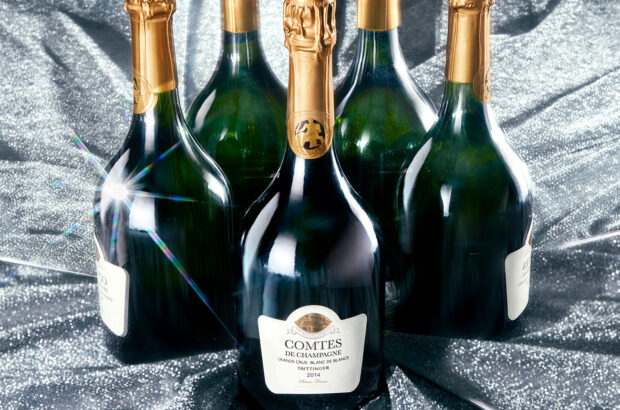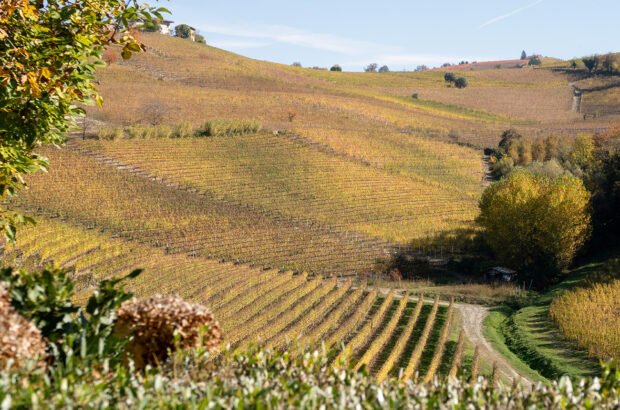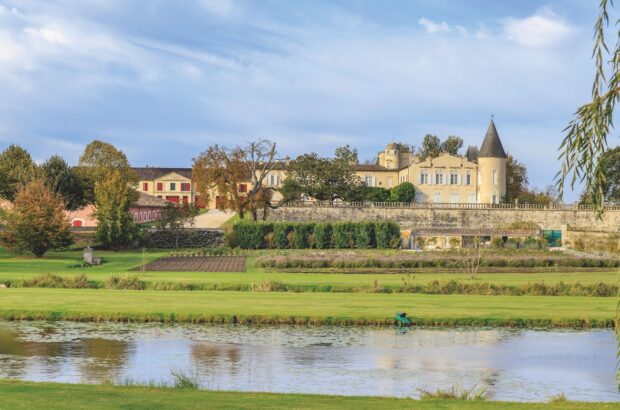Pre-millennium, the majority of non-vintage Champagne was made with very little reserve wine.
Most blends – and this includes nearly all of the major Champagne marques – came from one harvest base year, with relatively small amounts of reserve wine included, typically from the previous or two previous harvests. Reserve wine was barely 15% of the blend, and often a lot less.
Scroll down to see Giles Fallowfield’s Charles Heidsieck Mis en Cave tasting notes and scores
{"content":"PHA+U28gaXQgd2FzIGEgcmFkaWNhbCBtb3ZlIHdoZW4sIGJhY2sgaW4gMTk4NSwgQ2hhcmxlcyBIZWlkc2llY2sgaGVhZCB3aW5lbWFrZXIgRGFuaWVsIFRoaWJhdWx0IOKAkyDigJh0aGUgbmVhcmVzdCB0aGluZyB0byBhIGdlbml1cyB0aGUgcmVnaW9uIGhhcyBzZWVuIHNpbmNlIHRoZSB3YXIs4oCZIHRvIHF1b3RlIHRoZSBsYXRlIHdpbmUgd3JpdGVyIE5pY2sgRmFpdGgg4oCTIHNldCBhYm91dCBjb21wbGV0ZWx5IGNoYW5naW5nIHRoZSBtYWtlLXVwIG9mIHRoZSBicmFuZOKAmXMgQnJ1dCBSw6lzZXJ2ZSBOViBieSBpbmNvcnBvcmF0aW5nIGxhcmdlIGFtb3VudHMgb2Ygb2xkZXIgcmVzZXJ2ZSB3aW5lIGluIHRoZSBibGVuZCwgZ29pbmcgYmFjayBhcyBtYW55IGFzIGVpZ2h0IHllYXJzLjwvcD4KPHA+VGhpYmF1bHQgd2FzIGVuY291cmFnZWQgdG8gYnVpbGQgdXAgdGhlIGxhcmdlIHN0b2NrcyBvZiByZXNlcnZlIHdpbmUgaGUgbmVlZGVkIHRvIHdvcmsgaGlzIG1hZ2ljIGJ5IHRoZSBicmFuZOKAmXMgbmV3IG93bmVycyBSw6lteSBNYXJ0aW4sIGF0IHRoZSBjb3N0IG9mIGFsbG93aW5nIHNhbGVzIHRvIGZhbGwgc3Vic3RhbnRpYWxseS48L3A+CjxoMz5FeHRyYSBhZ2Vpbmc8L2gzPgo8cD5UbyBtYXJrIHRoZSBzaWduaWZpY2FudCBjaGFuZ2UgaW4gaXRzIG1ha2UtdXAsIHRoZSB3aW5lIHdhcyByZWxhdW5jaGVkIGFzIEJydXQgUsOpc2VydmUgTWlzZSBlbiBDYXZlLCB3aXRoIHRoZSB5ZWFyIGl0IHdhcyBmaXJzdCBjZWxsYXJlZCBwcmludGVkIGFib3ZlIHRoZSBtYWluIGxhYmVsLCB0aGlzIGluZGljYXRpbmcgdGhlIGNvbnNpZGVyYWJsZSBleHRyYSBhZ2VpbmcgdGhpcyBjdXbDqWUgcmVjZWl2ZWQsIGNvbXBhcmVkIHRvIGl0cyBub24tdmludGFnZSBwZWVycy4gQXQgbGVhc3QgdGhhdCB3YXMgdGhlIGlkZWEuPC9wPgo8cD48ZGl2IGNsYXNzPSJhZC1jb250YWluZXIgYWQtY29udGFpbmVyLS1tb2JpbGUiPjxkaXYgaWQ9InBvc3QtaW5saW5lLTIiIGNsYXNzPSJpcGMtYWR2ZXJ0Ij48L2Rpdj48L2Rpdj48L3A+CjxwPlRoZSBmaXJzdCBvZmZpY2lhbCByZWxlYXNlLCDigJhNaXMgZW4gQ2F2ZSAxOTky4oCZLCBpbmNsdWRlZCA0MCUgcmVzZXJ2ZSB3aW5lIGZyb20gZWlnaHQgZGlmZmVyZW50IHZpbnRhZ2VzIGFuZCA2MCUgZnJvbSB0aGUgYmFzZSB5ZWFyIG9mIDE5OTEsIGFuZCB3ZW50IG9uIHNhbGUgaW4gMTk5Ny4gTm8gbWFqb3IgQ2hhbXBhZ25lIGhvdXNlcyBhZ2VkIHRoZWlyIG5vbi12aW50YWdlIG5lYXJseSB0aGF0IGxvbmcsIG90aGVyIHRoYW4gS3J1ZyDigJMgd2hpY2gsIHBlcmhhcHMgbm8gY29pbmNpZGVuY2UsIFLDqW15IGFsc28gb3duZWQuPC9wPgo8cD5XaGlsZSB0aGUgTWlzIGVuIENhdmUgbGFiZWwgd2FzIG5vdCB1c2VkIHVudGlsIHRoZSAxOTkyIHJlbGVhc2UsIFRoaWJhdWx0IGNoYW5nZWQgdGhlIHN0eWxlIGZyb20gdGhlIG91dHNldCwgaGlzIGFpbSB0byBzaG93Y2FzZSB0aGUgcXVhbGl0eSBvZiB0aGUgbm9uLXZpbnRhZ2UgYmxlbmQuIFRoZSB3aW5lcyBiZWNhbWUgdW51c3VhbGx5IHJpY2ggYW5kIHRleHR1cmFsbHkgY29tcGxleCwgc2hvd2luZyBhIGRpc3RpbmN0IHRvdWNoIG9mIHZhbmlsbGEgd2l0aCBhZ2UgdGhhdCBzdWdnZXN0ZWQgb2FrLCB0aG91Z2ggbm9uZSB3aGF0c29ldmVyIHdhcyB1c2VkLjwvcD4KPHA+SW4gdGhlIHJ1bi11cCB0byB0aGUgTWlsbGVubml1bSAoTWF5IDE5OTkpLCBibGVuZHMgZ29pbmcgYmFjayB0byB0aGF0IGJhc2VkIG9uIHRoZSAxOTg2IGhhcnZlc3Qgd2VyZSByZS1yZWxlYXNlZCBieSBSw6lteSB1bmRlciB0aGUg4oCYTWlzIGVuIENhdmXigJkgbGFiZWwgdGhhdCBoYWRu4oCZdCBiZWVuIHVzZWQgZm9yIHRoZW0gaW5pdGlhbGx5LCBhcyBwYXJ0IG9mIGEgc3BlY3RhY3VsYXIg4oCYb2Vub3RoZXF1ZSBjb2xsZWN0aW9u4oCZIG9mIDE2IENoYW1wYWduZXMuIFRoaXMgaW5jbHVkZWQgdGhlIDE5ODYtYmFzZWQgd2luZSBpbiBqZXJvYm9hbSwgbm93IGxhYmVsbGVkIE1pcyBlbiBjYXZlIDE5ODcsIHBsdXMgYSAxOTg4IGFuZCAxOTkwIE1pcyBlbiBDYXZlIGluIGJvdHRsZSAoNzVjbCkg4oCTIGFsbCB0aHJlZSBvZiB3aGljaCBhcmUgaW5jbHVkZWQgaW4gdGhpcyB0YXN0aW5nLCAzMCB5ZWFycyBvciBtb3JlIG9uLjwvcD4KPGRpdiBjbGFzcz0iYWQtY29udGFpbmVyIGFkLWNvbnRhaW5lci0tbW9iaWxlIj48ZGl2IGlkPSJwb3N0LWlubGluZS0zIiBjbGFzcz0iaXBjLWFkdmVydCI+PC9kaXY+PC9kaXY+CjxoMz5DdWx0IGZvbGxvd2luZzwvaDM+CjxwPkJ5IG1pZC0xOTk3IHRoZXJlIHdlcmUgdGhyZWUgZGlmZmVyZW50IE1pcyBlbiBDYXZlIHdpbmVzIG9uIHRoZSBtYXJrZXQgYXQgdGhlIHNhbWUgdGltZSwgMTk5MiwgMTk5MyBhbmQgMTk5NCDigJMgYWxsIGRlbW9uc3RyYXRpbmcgaG93IGhpZ2gtcXVhbGl0eSwgbm9uLXZpbnRhZ2UgQ2hhbXBhZ25lIGFnZXMgb24gaXRzIGxlZXMgYW5kIGRldmVsb3BzIG92ZXIgdGltZS4gV2hpbGUgdGhlc2Ugd2luZXMgaGFkIGEgc21hbGwgY3VsdCBmb2xsb3dpbmcsIGluY2x1ZGluZyB0aGlzIHdyaXRlciwgYW5kIHdvbiBqdXN0IGFib3V0IGV2ZXJ5IGFjY29sYWRlIGdvaW5nIG9uIHRoZSB3aW5lIGF3YXJkIGNpcmN1aXQsIGluZXhwbGljYWJseSB0aGV5IHdlcmUgbm90IHJlYWxseSBjb21tZXJjaWFsbHkgc3VjY2Vzc2Z1bC48L3A+CjxwPlBhcnQgb2YgdGhlIHByb2JsZW0sIGl0IHNlZW1zLCB3YXMgdGhhdCBwZW9wbGUgZGlkbuKAmXQgdW5kZXJzdGFuZCB0aGUgTWlzIGVuIENhdmUgY29uY2VwdCwgYW5kIG1hbnkgdGhvdWdodCB0aGUgeWVhciBkYXRlIGluZGljYXRlZCBhIHZpbnRhZ2UgQ2hhbXBhZ25lLiBNaXMgZW4gQ2F2ZSBCcnV0IFLDqXNlcnZlIDE5OTgsIGxhdW5jaGVkIGluIE1heSAyMDAzLCB3YXMgdGhlIGxhc3Qgbm9uLXZpbnRhZ2UgcmVsZWFzZSB0byBjYXJyeSB0aGlzIGVwaXRoZXQgb24gdGhlIGJvdHRsZSwgdGhvdWdoIHRoZSBuYW1lIHdhcyBzdGlsbCB1c2VkIHRvIG1hcmtldCB0aGUgd2luZXMuPC9wPgo8ZGl2IGNsYXNzPSJhZC1jb250YWluZXIgYWQtY29udGFpbmVyLS1tb2JpbGUiPjxkaXYgaWQ9InBvc3QtaW5saW5lLTQiIGNsYXNzPSJpcGMtYWR2ZXJ0Ij48L2Rpdj48L2Rpdj4KPHA+QnkgdGhlIHRpbWUgUsOpbXksIHdoaWNoIGhhZCBjbGVhcmx5IGxvc3QgaW50ZXJlc3QgaW4gQ2hhbXBhZ25lLCBzZWxsaW5nIEtydWcgdG8gTW\/Dq3QgSGVubmVzc3kganVzdCBiZWZvcmUgdGhlIE1pbGxlbm5pdW0sIHNvbGQgQ2hhcmxlcyBIZWlkc2llY2sgdG8gdGhlIGx1eHVyeSBnb29kcyBFUEkgZ3JvdXAgaW4gMjAxMSwgc2FsZXMgaGFkIGR3aW5kbGVkIHRvIGp1c3QgMzUwLDAwMCBib3R0bGVzLiBEaXJlY3RvciBvZiB0aGUgaG91c2UgU3RlcGhhbiBMZXJvdXggY2hhcmFjdGVyaXNlcyB0aGUgcGVyaW9kIG9mIFLDqW15IG93bmVyc2hpcCBmcm9tIDE5ODUgdG8gMjAxMSwgYXMgb25lIHdpdGgg4oCYbm8gcGlsb3QgaW4gdGhlIHBsYW5lLiBTYWxlcyBmZWxsIGZyb20gNW0gdG8gMW0gaW4gdGhlIGZpcnN0IDEwIHllYXJzLOKAmSBoZSBzYXlzLjwvcD4KPGgzPk5ldyBjaGFwdGVyPC9oMz4KPHA+VGhlIGN1cnJlbnQgb3duZXIgRVBJIGhhcyBtYWRlIGdyZWF0IHN0cmlkZXMgaW4gcmVzdG9yaW5nIENoYXJsZXMgSGVpZHNpZWNr4oCZcyByZXB1dGF0aW9uIGFuZCBncmFkdWFsbHkvc3RlYWRpbHkgcmVidWlsZGluZyBzYWxlcy4gVGhlIHF1YWxpdHkgb2YgdGhlIHdpbmVzIGhhcyBuZXZlciBmYWx0ZXJlZCB1bmRlciB0aGUgc3Rld2FyZHNoaXAgb2YgdGFsZW50ZWQgY2hlZnMgZGUgY2F2ZXMsIHdpdGggUmVnaXMgQ2FtdXMgaW5pdGlhbGx5IGZvbGxvd2luZyBUaGliYXVsdCwgd2hvIGRpZWQgcHJlbWF0dXJlbHkgaW4gMjAwMiwgYW5kIEN5cmlsIEJydW4gbW92aW5nIGZyb20gVmV1dmUgQ2xpY3F1b3QgdG8gdGFrZSB0aGUgaGVsbSBpbiBNYXkgMjAxNS48L3A+CjxkaXYgY2xhc3M9ImFkLWNvbnRhaW5lciBhZC1jb250YWluZXItLW1vYmlsZSI+PGRpdiBpZD0icG9zdC1pbmxpbmUtNSIgY2xhc3M9ImlwYy1hZHZlcnQiPjwvZGl2PjwvZGl2Pgo8cD5BbGwgdGhlIOKAmE1pcyBlbiBDYXZl4oCZIHdpbmVzIGFyZSBiZWluZyByZS1yZWxlYXNlZCwgYW5kIGluIGEgWm9vbSB2ZXJ0aWNhbCB0YXN0aW5nLCBoZWxkIHNpbXVsdGFuZW91c2x5IGluIDEyIGNvdW50cmllcywgQnJ1biB0YWxrZWQgam91cm5hbGlzdHMgdGhyb3VnaCBlaWdodCB3aW5lcywgc3RhcnRpbmcgd2l0aCBoaXMgb3duIGZpcnN0IHN1Y2ggY3JlYXRpb24sIE1pcyBFbiBDYXZlIDIwMTcsIGVsYWJvcmF0ZWQgZnJvbSB0aGUgMjAxNiBoYXJ2ZXN0LjwvcD4KPGRpdiBjbGFzcz0iaW5qZWN0aW9uIj48L2Rpdj4KPHA+QnJ1biBzYXlzIHRoZSBzdHlsZSwg4oCYcGluZyBwb25ncyBiZXR3ZWVuIHJlZHVjdGlvbiBhbmQgb3hpZGF0aW9uLiBUZXh0dXJhbGx5IGl04oCZcyBzaWxreSwgcGFydGx5IGNyZWF0ZWQgYnkgc3VwZXIgc21hbGwgYnViYmxlcy4gSXTigJlzIG5vdCBzbyBtdWNoIHJpcGUgZnJ1aXQgYXMgZHJpZWQgZnJ1aXQgd2l0aCBzbW9reSByb2FzdCBub3RlcyB0b28u4oCZIEZvciB0aGUgZmlyc3QgdGltZSBoZSBoYXMgaW50cm9kdWNlZCBzb21lIG9hayBhZ2VpbmcgaW50byB0aGUgYmxlbmQ6IOKAmEl0IGhlbHBzIGtuaXQgdGhlIGVsZW1lbnRzIHRvZ2V0aGVyLCBicmluZ2luZyBtb3JlIHRleHR1cmFsIGNvbXBsZXhpdHkgZWFybGllciBpbiB0aGUgd2luZeKAmXMgZXZvbHV0aW9uLCB0aGUgZXF1aXZhbGVudCBvZiBhbiBleHRyYSB5ZWFyIG9uIGl0cyBsZWVzLuKAmTwvcD4KPHA+Tm93IHdoZW4gZGV2b3RlZXMgb2YgQ2hhcmxlcyBIZWlkc2llY2sgZmluZCBhIG5vdGUgb2YgdmFuaWxsYSBpbiB0aGUgQnJ1dCBSw6lzZXJ2ZSwgdGhleSB3aWxsIGtub3cgdGhlIG9hayBpbmZsdWVuY2UgaXMgYWN0dWFsbHkgdGhlcmUsIGFsYmVpdCBzdWJ0bGUgYW5kIGluIHRoZSBiYWNrZ3JvdW5kLjwvcD4KPHA+V2luZXMgYXJlIGF2YWlsYWJsZSBmcm9tIDxhIGhyZWY9Imh0dHBzOi8vdGhlZmluZXN0YnViYmxlLmNvbSIgdGFyZ2V0PSJfYmxhbmsiIHJlbD0ibm9mb2xsb3cgbm9vcGVuZXIgbm9yZWZlcnJlciI+VGhlIEZpbmVzdCBCdWJibGU8L2E+LjwvcD4KPHA+Cg=="}
See Giles Fallowfield’s Charles Heidsieck Mis en Cave tasting notes and scores
{}
{"wineId":"43410","displayCase":"standard","paywall":true}
{"wineId":"43411","displayCase":"standard","paywall":true}
{"wineId":"43412","displayCase":"standard","paywall":true}
{"wineId":"43413","displayCase":"standard","paywall":true}
{"wineId":"43414","displayCase":"standard","paywall":true}
{"wineId":"43415","displayCase":"standard","paywall":true}
{"wineId":"43416","displayCase":"standard","paywall":true}
{"wineId":"43417","displayCase":"standard","paywall":true}
{}
You may also like












